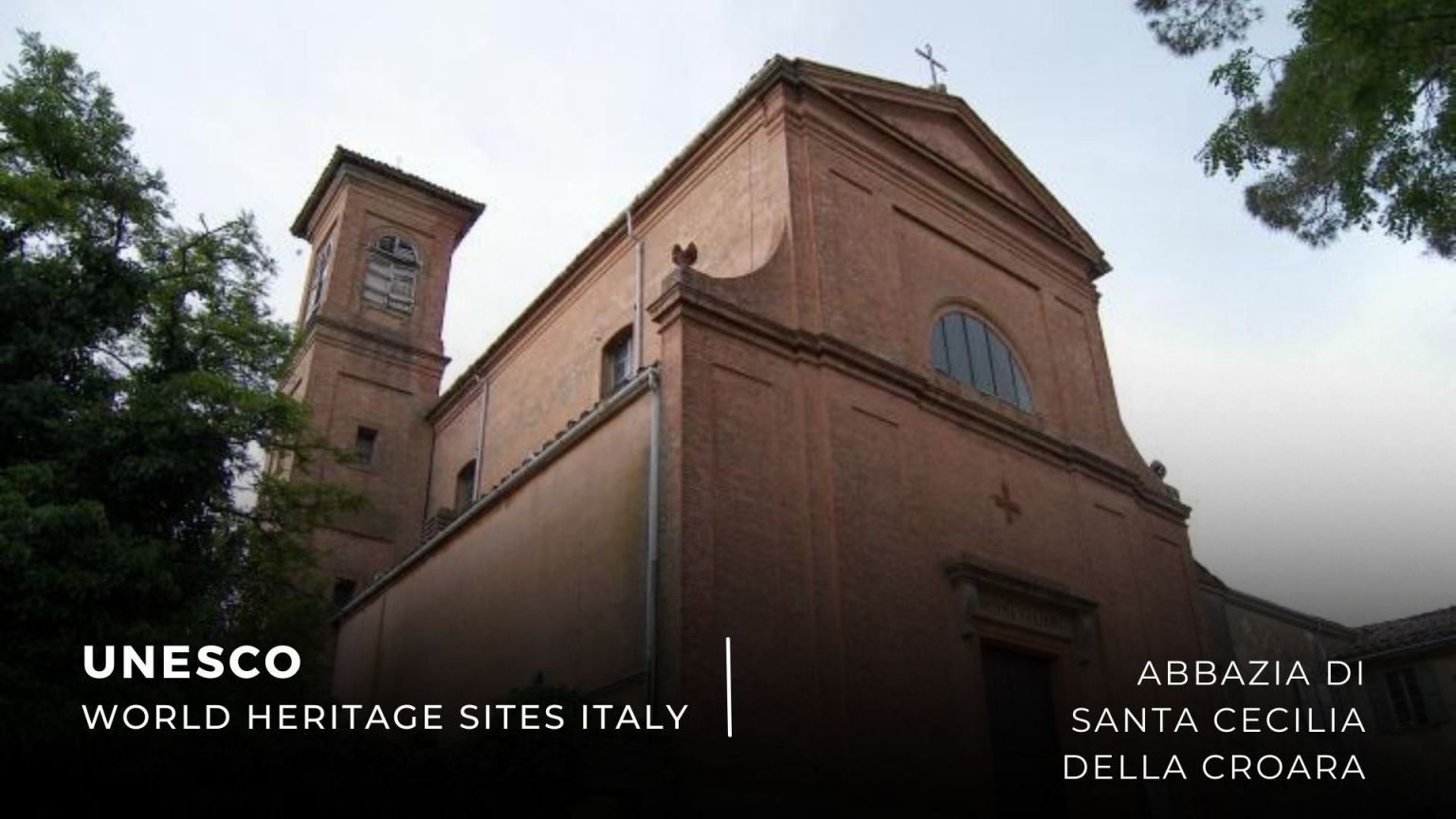The Abbey of Santa Cecilia della Croara in San Lazzaro di Savena is a place of peace and beauty with timeless charm. This ancient Benedictine monastery rises in the heart of a region already rich in UNESCO World Heritage sites.
A little off the radar but still easily accessible, it is worth taking a diversion to find it amidst the gentle Bolognese landscapes. Here's why.

The Abbey of Santa Cecilia della Croara, a UNESCO Heritage Site in Emilia Romagna
The Abbey of Santa Cecilia della Croara is a little gem hidden in the hills of San Lazzaro di Savena. You can find this UNESCO Monument Witness to a Culture of Peace just a few kilometres from Bologna.
An array of buildings - the church, cloister, bell tower, the former convent, and a small cemetery - make up a place that, although inevitably marked by time, remains cloaked in a mystical and solemn atmosphere.
L'Abbazia already existed in the 12th century, as attested in an official document dated 14 November 1095.
Probably, the Abbey della Croara was built on the remains of an ancient Roman domus, still visible today inside the cloister. In summer, il chiostro becomes the setting for concerts and open-air shows, cultural events that pervade a space that has always been devoted to beauty. From here, the panorama of Bologna and its hills is enchanting.
The abbey holds some interesting works of sacred art. Not many have survived, but those that have endured the passage of centuries retain all the eloquent and evocative charm of such a majestic and austere place.
The Stations of the Cross in polychrome terracotta dates back to the 17th century, as does the Saint Cecilia on the high altar and the painting of Saint Jerome, both by Mastelletta. There is also a Saint Anthony of Padua from the school of Guido Reni and the altarpiece depicting the Infant Jesus by the Bolognese painter Annibale Carracci.
Originally the abbey was a Benedictine monastery, a point of reference for the local community and the driving force behind agricultural production in the area. Furthermore, thanks to the intuition of the monks, viticulture also underwent such a boost that the wine produced became a major source of income for the abbey and a distinctive sign of a region still known today for the presence of important wineries.
Exploring the surroundings of the Abbey of Santa Cecilia della Croara
The Abbey of Santa Cecilia della Croara is in San Lazzaro di Savena, a plain town sited along the Via Emilia, a millenary road that has witnessed the history of Italy from 187 BC to the present day.
The conformation of San Lazzaro has been gradually defined over time. Beginning in the Middle Ages, it went from being a lazaret with only a hospital and an oratory around to becoming first a rural village and finally a true town, almost an offshoot of Bologna.
An area dotted with fascinating religious and civil buildings, with a succession of aristocratic residences and the princely Dolfi Ratta castle, San Lazzaro is home to approximately 30.000 inhabitants. And to a herd of dinosaurs, too.
T-rex and friends - more than 50 life-size models of prehistoric animals - stand tall, fanged and, in some cases, menacing in the Dinosaurs in Flesh and Bone Park and the Luigi Donini Museum of Prehistory. Together, the two cultural hubs form the largest prehistoric animal theme park in Italy.
San Lazzaro di Savena is surrounded by nature at its very best, a pleasure even for the most skilled hikers. The surrounding karst hills, part of the Parco dei Gessi Bolognesi e Calanchi dell'Abbadessa, boast spectacular rock cavities. La Grotta del Farneto and La Grotta della Spipola are among the must-see attractions. You can explore both the grottos in a guided tour.
In the hamlet of Idice, the Molino Grande River Oasis encompasses lake and woodland landscapes that are the ideal habitat for a large number of birds.
Also, San Lazzaro is an attractive destination for cycling enthusiasts. The various itineraries along the cycle routes through the hills are well signposted from the station.
The UNESCO Sites of Emilia Romagna
Emilia Romagna counts thirteen UNESCO sites, including the Abbey of Santa Cecilia della Croara in San Lazzaro di Savena, a Monument messenger of a culture of peace.
Starting with Bologna, a UNESCO Creative City of Music since 2006. In 2021, it was the turn of its famous porticos, proclaimed a World Heritage Site. The serial site includes a selection of 12 covered passageways among the most representative of Bologna's social and urban conformation. Walking on them means strolling along nine centuries of history.
Ravenna, the city of mosaics, is home to eight early Christian and Byzantine monuments that have been UNESCO World Heritage Sites since 1996: the Basilica of San Vitale, the Chapel of Sant'Andrea, the Basilica of Sant'Apollinare Nuovo, Sant'Apollinare in Classe, the Mausoleum of Galla Placidia, the Mausoleum of Theodoric, the Baptistery of the Arians and the Neonian Baptistery.
Ferrara, a harmonious example of Renaissance town planning, stands out for its historic centre, the Este family's network of noble residences, and the Po delta.
Modena, with its Piazza Grande, the Cathedral and Ghirlandina Tower. Approximately 90 metres high, it has towered white, bright and graceful for 1,000 years.
The Sasso Fratino Forest, 800 hectares covered in ancient beech woods.
The Malatesta Library of Cesena, a 15th-century gem, has been part of the Memory of the World Register since 2005. A rare example of a humanistic Renaissance library in perfect condition, it was the first civic library in Italy.
La Chiusa di Casalecchio di Reno, a grandiose hydraulic work from the Middle Ages, a Monument messenger of a culture of peace since 2010.
The International Museum of Ceramics in Faenza houses 60,000 ceramic works of art from the most diverse periods and places, from Ancient Mesopotamia to the present day.
A centre of art and taste, Parma has been a UNESCO Creative City for Gastronomy since 2015. It's home to the European Food Safety Authority, the International School of Italian Cuisine and a network of Food Museums.
The UNESCO MAB Reserve of the Tuscan-Emilian Apennines, between Parma and Reggio Emilia. A particularly lush naturalistic area rich in animal and plant species.
The Po Delta Park, a UNESCO MAB Reserve, is a paradise for birdwatchers with more than 350 species of birds in a spectacular landscape of lagoons, pine forests, valleys and salt marshes.
The course of the Po River, a UNESCO MAB Reserve that crosses the Piacenza, Parma and Reggio Emilia areas, meets poplars, river woods, small beaches and villages.
About the author
Written on 10/01/2023



Lorena Calise
Abbey of Santa Cecilia della Croara: discover a secret place where peace and beauty reign in the heart of the Bolognese countryside.